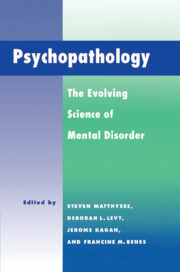Book contents
- Frontmatter
- Contents
- List of Contributors
- Preface
- Brain mechanisms
- Development
- Thinking
- 13 Editor's introduction: Upward toward phenomenology, downward toward physiology
- 14 The psychometric assessment of schizophrenia proneness
- Comments on Jean P. Chapman and Loren J. Chapman's chapter
- 15 Politeness in schizophrenia
- Comments on Roger Brown's chapter
- 16 Neuroleptic treatment effects in relation to psychotherapy, social skills training, and social withdrawal in schizophrenics
- Comments on Herbert E. Spohn's chapter
- 17 Familial factors in the impairment of attention in schizophrenia: Data from Ireland, Israel, and the District of Columbia
- 18 Parsing cognitive processes: Psychopathological and neurophysiological constraints
- 19 Cognitive psychopathology in schizophrenia: Explorations in language, memory, associations, and movements
- Genetics
- Response and reflections
- Author index
- Subject index
18 - Parsing cognitive processes: Psychopathological and neurophysiological constraints
Published online by Cambridge University Press: 04 May 2010
- Frontmatter
- Contents
- List of Contributors
- Preface
- Brain mechanisms
- Development
- Thinking
- 13 Editor's introduction: Upward toward phenomenology, downward toward physiology
- 14 The psychometric assessment of schizophrenia proneness
- Comments on Jean P. Chapman and Loren J. Chapman's chapter
- 15 Politeness in schizophrenia
- Comments on Roger Brown's chapter
- 16 Neuroleptic treatment effects in relation to psychotherapy, social skills training, and social withdrawal in schizophrenics
- Comments on Herbert E. Spohn's chapter
- 17 Familial factors in the impairment of attention in schizophrenia: Data from Ireland, Israel, and the District of Columbia
- 18 Parsing cognitive processes: Psychopathological and neurophysiological constraints
- 19 Cognitive psychopathology in schizophrenia: Explorations in language, memory, associations, and movements
- Genetics
- Response and reflections
- Author index
- Subject index
Summary
The concept of attention is most intriguing since, at first glance, it appears impossible to study. Somehow it seems more feasible to examine and determine the basic structure of perceptual or mnemonic processes – establishing parameters such as perceptual thresholds and memory capacities. It is unsettling to learn that a slight attentional change, for example in the instructions of a task, can radically change these so-called parameters of the system. That is, telling a subject where a target is likely to appear, or what target is likely to appear, might determine whether or not the subject will be able to detect, discriminate, or even remember the target.
The relation between attention and eye movements
The relation between eye movements and attention has been discussed for over a century, but usually in the context of dissociating attention from eye movements. In 1890, William James in The Principles of Psychology noted that “we may attend to an object on the periphery of the visual field and yet not accommodate the eye for it” (p. 413). He further elaborated by referring to Helmholtz, who, according to James, “states the fact so strikingly that I will quote his observations in full” (p. 414).
- Type
- Chapter
- Information
- PsychopathologyThe Evolving Science of Mental Disorder, pp. 407 - 432Publisher: Cambridge University PressPrint publication year: 1996
- 2
- Cited by



